The main advantage of telescopic hoods is saving space in the kitchen. Such devices look neat, giving the kitchen set lightness, and also significantly reduce the likelihood of collision with the traditional «dome». Today we are reviewing the Haier HVX-T662BB hood, which stands out with its elegant design and black filters. Externally, it looks great, but what about practicality? Let's figure it out!
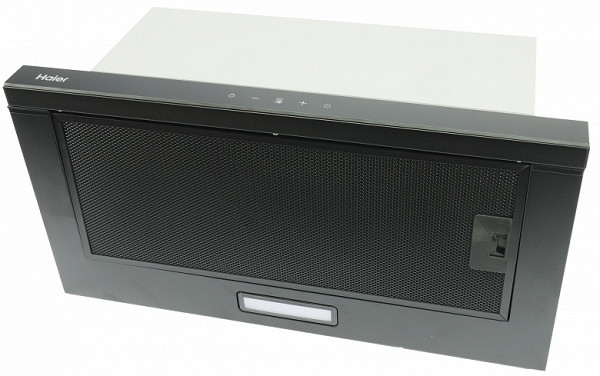
Characteristics
| Manufacturer | Haier |
|---|---|
| Model | HVX-T662BB |
| Type | built-in telescopic kitchen hood |
| Country of origin | China |
| Guarantee | 1 year (additional service — 3 years) |
| Service life * | 7 years |
| Control | touch buttons |
| Power consumption | 182 W |
| Performance | 600 m³/h |
| Number of speeds | 3 |
| Noise level | up to 68 dB |
| Filter | aluminum carbon HAX-22, 2 pcs. (purchased separately) |
| Backlight | LED, 2.3 W |
| Weight | 8 kg |
| Dimensions (W×D×H) | 600×(282—460)×285 mm |
| Dimensions for installation (W×H×D) | 50.4×23.2×31.2 cm |
| Length of network cable | 1 m |
* Contrary to popular belief, this is not a period after which the device will necessarily break down. However, after this period, the manufacturer ceases to bear any responsibility for its functionality and has the right to refuse to repair it, even for a fee.
Equipment
The hood arrived in a simple brown cardboard box with the brand and model listed on it. The packaging is minimalist, clearly indicating its primary purpose — to ensure the safe delivery of the unit to its destination. It is clearly not intended for display.

Brief technical specifications and manufacturer's contact information are indicated on the sides of the box.
After opening the package, we found inside:
- a complete hood with installed aluminum grease filters,
- a 150 mm diameter check valve,
- a set of fasteners (washers, self-tapping screws, screws, 4 pieces each),
- a user manual.
At first glance
After unpacking, we found a very typical device in front of us: telescopic hoods are similar in their design in many ways, and you will hardly find any innovations here. Let's list the main features of such models.
Firstly, they are intended exclusively for built-in installation. The user has only the control panel located on the retractable part of the hood, and the lower surface with two grease filters. Everything else is hidden behind the facade of the kitchen set.



On the front (retractable) panel of the hood we see the manufacturer's logo, as well as a set of touch buttons and a digital LED indicator.
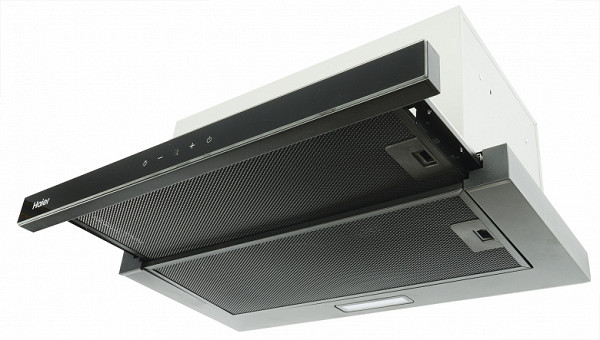
On the underside of the hood, you can see one LED lampshade and an aluminum grease filter. In our model, the filter is painted black, which we really liked: grease stains on the black surface should be less noticeable than on the classic metal version. However, the question arises: will cleaning the filter with a brush damage the paint and cause it to lose its original appearance?
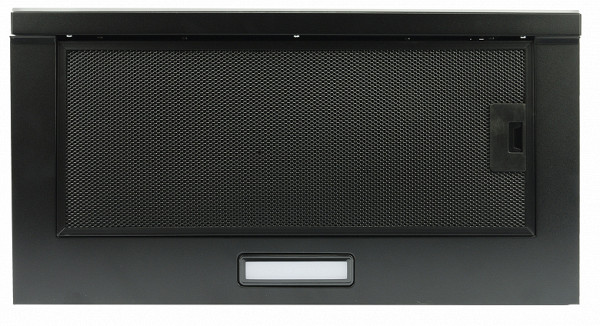
The filter mount is standard — «ears» on one side, and a plastic latch on the other.
The LED backlight shines with a bright, slightly warm light. The lamp power is 2.4 W.

Inside the sliding panel there is a second anti-grease filter, completely identical to the first.

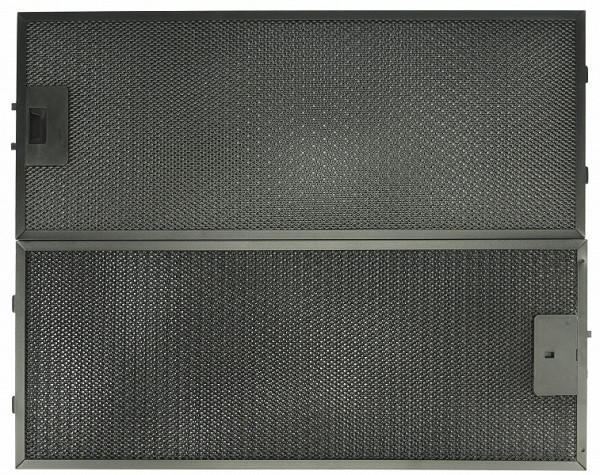
The design of the filters is well known to every owner of a kitchen hood: a voluminous aluminum mesh designed to trap splashes of fat and oil is fixed to a metal frame with plastic latches.
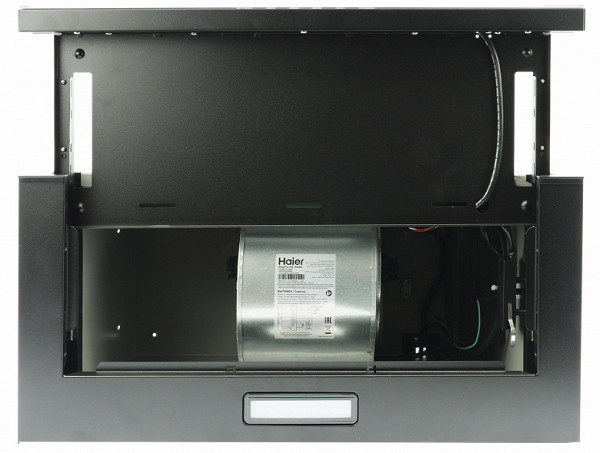
The interior of the pull-out section has no openings: the device is activated only when unfolded. Inside the housing there is an electronic control unit and a fan motor in a cylindrical housing.
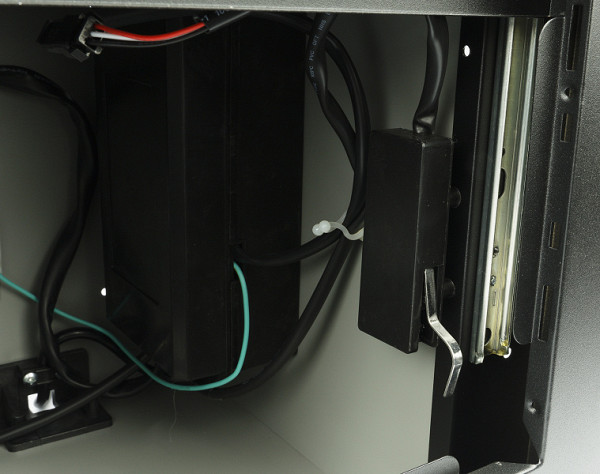
The ends of the motor block have places for installing additional filters. If you plan to use the device without connecting to the exhaust ventilation, you can install carbon cartridges here, purchased separately. These cartridges are available on the manufacturer's website under the article number HAX-22. Two cartridges are required for operation, the total cost of which will be about $33.
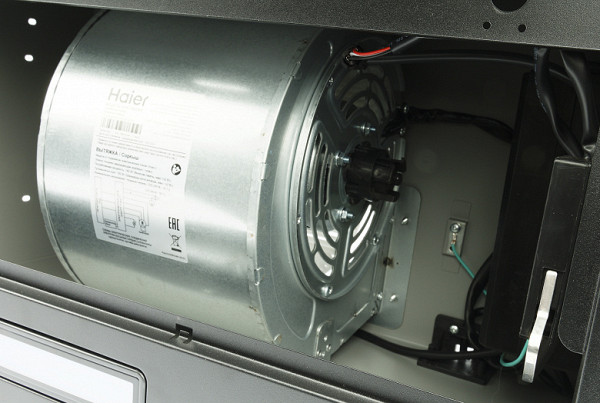
If the device is planned to be connected to an exhaust ventilation system, the included non-return valve must be installed on the outlet.

The plastic structure with a diameter of 120 mm is equipped with two valves that prevent dust and polluted air from the ventilation pipes from entering the device. This ensures that the smell of fried chicken from the neighboring apartment does not penetrate into your premises.
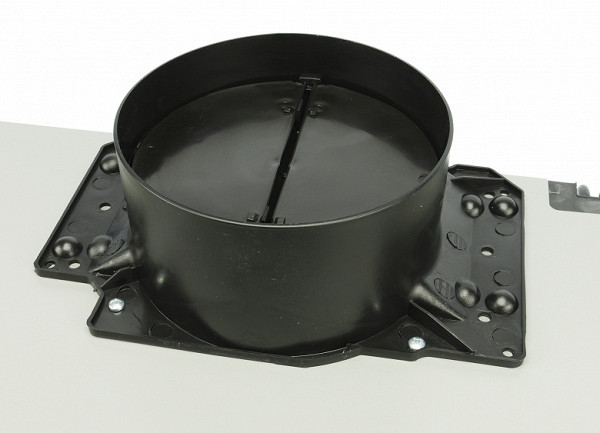
The valve is secured to the body using four screws, which can be found in the box with the hood.
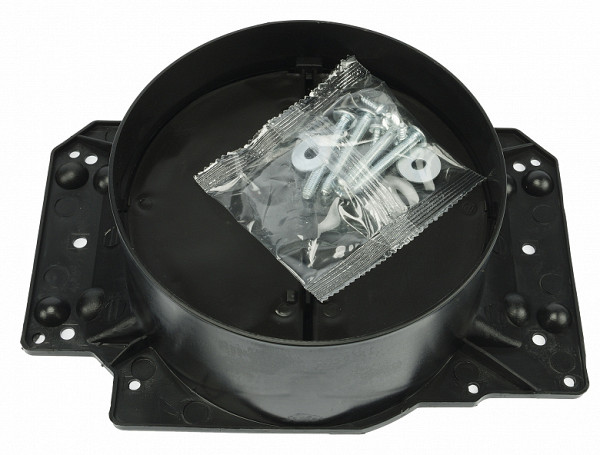
An electric cable with a two-pole plug comes out of the upper part of the body. The cable length is 1 meter.
Instructions
The user manual is a black and white A5 brochure printed on quality paper. The manual is written in two languages, with Russian accounting for 18 pages.
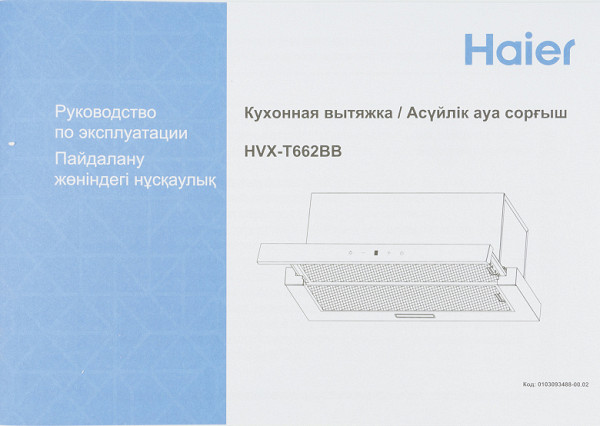
The manual includes detailed technical specifications of the device, installation and operating instructions, tips for caring for the device, as well as a table with possible malfunctions and how to eliminate them.
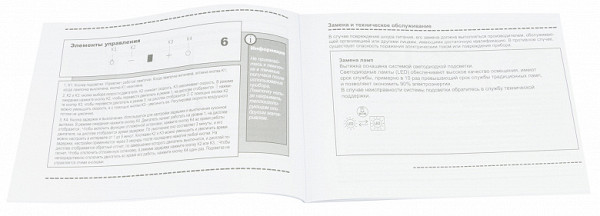
We found many illustrations in the brochure, which makes it very easy to understand all the nuances.
Control
The control panel is located on a sliding glass panel and includes four touch buttons with white LED backlighting. In the center is a digital LED indicator displaying one digit.
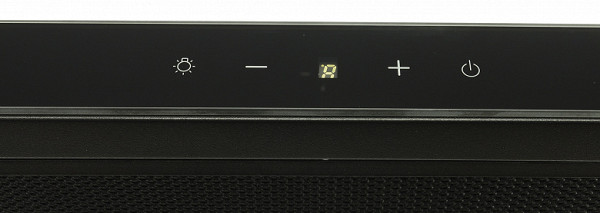
The purpose of most of the buttons on the control panel is intuitive:
- Turn the backlight on/off
- Reduce power/timer
- Increase power/timer
- Turn the hood on/off and set the timer (more on that later)
Each press is accompanied by a quiet sound signal.
The pull-out panel is equipped with a limit sensor that automatically turns off the lighting and ventilation when folding.
When the panel is pulled out, the hood gives a short sound signal and illuminates the buttons for a second, which is convenient for use at night without turning on the general light.
The power button switches the hood to minimum power mode. The “+” and “−” buttons adjust the power within the range from the first to the third.
However, there were some difficulties with the automatic shutdown timer. To set the delay timer, you need to press the power button while the hood is running, and then use the “+” and “−” buttons to select a time from 1 to 9 minutes (by default — 3 minutes). The settings are applied after 3 seconds of inactivity, after which the display shows the remaining time until shutdown.
The timer is switched off using the "-" or "+" buttons, and the «on/off» button when the timer is running will simply switch off the hood, but will not cancel the timer.
Additional confusion arises because the default timer value (3 minutes) is easily confused with the third power.
Overall, the hood is not particularly difficult to operate in daily use, but it can be difficult to explain the control features to new users.
Operation
We do not traditionally test hoods in real kitchen conditions due to installation variations. Our measurements are limited to laboratory tests: measuring performance, noise level and energy consumption.
During our tests, we found that the control buttons are conveniently located and respond well to pressing. They are intuitive to use, with the exception of setting the automatic shutdown timer.
The LED backlighting has good brightness, which allows you to perform simple tasks in the kitchen in low light. In addition, it can serve as a night light.
Care
To clean the metal body parts, it is recommended to use a hot soapy solution and a soft cloth. Do not use hard or abrasive materials.
The glass panel should be cleaned with a glass cleaner, and the controls should be wiped with a soapy solution, then completely dried with a clean cloth. Before servicing, the hood must be disconnected from the mains.
The aluminum grease filters should be cleaned every three months. To do this, they can be washed with water and detergent after pre-soaking and thoroughly dried before reinstalling. They can also be washed in the dishwasher at a temperature not exceeding 60 °C. After washing in the dishwasher, the aluminum may change color — this is normal and does not affect the operation of the filters. The question remains as to how this will affect the black paint.
The carbon filters used in recirculation mode should be replaced every 3-6 months or as needed.
Our measurements
The energy consumption of the hood depends, of course, on the speed of its fans.
| Power consumption, W | |
|---|---|
| Speed 1 | 96 |
| Speed 2 | 136 |
| Speed 3 | 180 |
| Lighting | 2.4 |
As promised by the manufacturer, everything corresponds to the declared characteristics!
We measured the noise level by placing the sound level meter microphone at a distance of 1 m from the working hood and pointing it at it. To create the most realistic conditions, a 2-meter pipe was connected to the hood outlet, which allowed us to isolate the «rear» noise and minimize its impact on the measurement results.
| Noise level, dBA | |
|---|---|
| Speed 1 | 55 |
| Speed 2 | 59 |
| Speed 3 | 65 |
The manufacturer confirmed its words once again: we were promised up to 68 dBA, and according to our measurements, the noise level was even a little less — 65 dBA.
As usual, to measure the performance, we connected the hood to a two-meter smooth PVC pipe with a diameter of 160 mm so that the air flow speed in different sections at the outlet of the device stabilized. We measured the air speed at 17 points on the outer opening of the pipe, and then calculated the arithmetic mean.
Based on the average speed, we determined the performance of the hood in cubic meters of air per minute. The measurement results for this model are as follows (the numbers are the speed in meters per second).
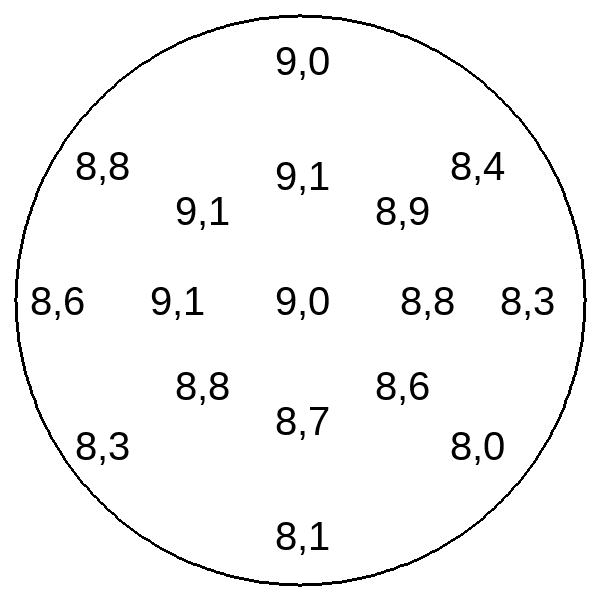
The average air flow velocity at the outlet of the pipe was 8.68 m/s. Given the pipe diameter of 160 mm, the hood performance was 10.47 cubic meters per minute (628.13 m³/h). Comparing with the passport data, where 600 m³/h is declared, we see that the hood even slightly exceeded the declared indicators. Very nice!
Conclusions
The Haier HVX-T662BB hood impressed with its strict design, which will harmoniously fit into any kitchen interior. Control of the device turned out to be simple and convenient, although setting the shutdown timer can cause some difficulties. LED lighting effectively illuminates the stove and hob, and also serves as a soft night light.
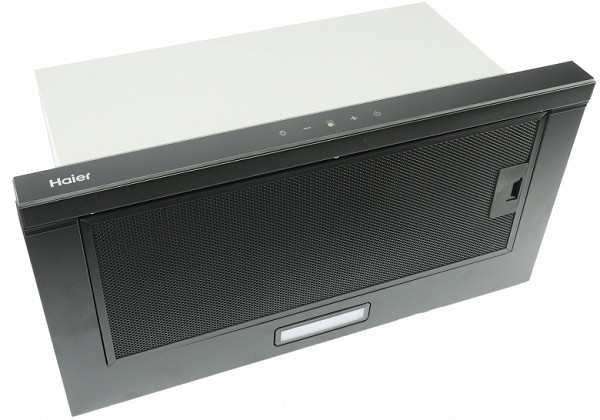
In lab tests, the hood showed excellent performance results for its class, although the noise level was slightly higher than expected. Despite the declared maximum of 68 dBA, we measured up to 65 dBA. However, the performance was even slightly higher than stated — 628 m³/h against the promised 600 m³/h.
The retractable panel made of black glass looks impressive, but requires regular cleaning, as it easily collects fingerprints.
Pros:
- great design
- good performance
Cons:
- high noise level at maximum power
